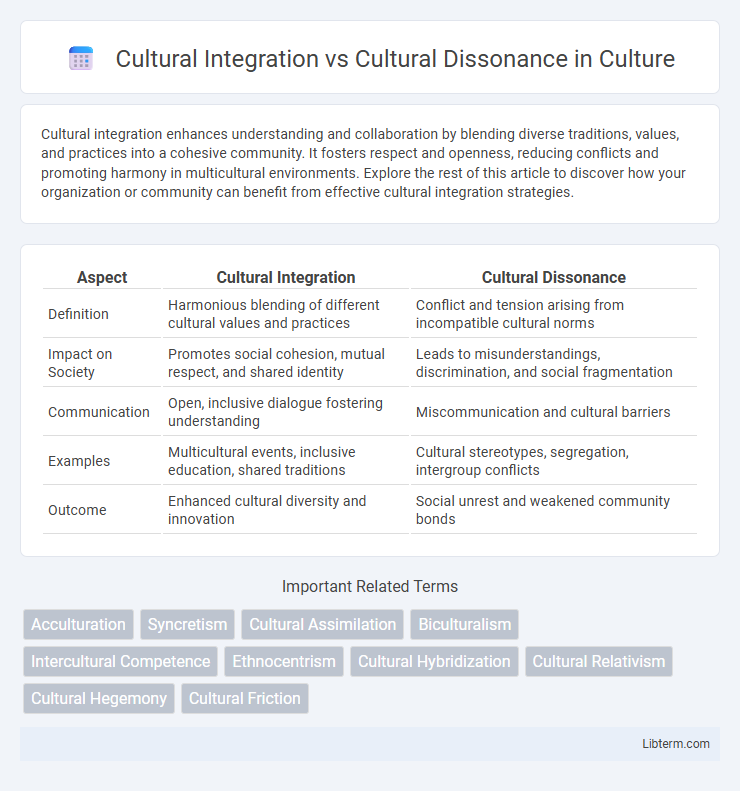Cultural integration enhances understanding and collaboration by blending diverse traditions, values, and practices into a cohesive community. It fosters respect and openness, reducing conflicts and promoting harmony in multicultural environments. Explore the rest of this article to discover how your organization or community can benefit from effective cultural integration strategies.
Table of Comparison
| Aspect | Cultural Integration | Cultural Dissonance |
|---|---|---|
| Definition | Harmonious blending of different cultural values and practices | Conflict and tension arising from incompatible cultural norms |
| Impact on Society | Promotes social cohesion, mutual respect, and shared identity | Leads to misunderstandings, discrimination, and social fragmentation |
| Communication | Open, inclusive dialogue fostering understanding | Miscommunication and cultural barriers |
| Examples | Multicultural events, inclusive education, shared traditions | Cultural stereotypes, segregation, intergroup conflicts |
| Outcome | Enhanced cultural diversity and innovation | Social unrest and weakened community bonds |
Understanding Cultural Integration: Definition and Importance
Cultural integration refers to the process by which individuals or groups adopt and blend elements from different cultures, fostering social cohesion and mutual respect. This dynamic enhances communication, collaboration, and shared values within diverse societies or organizations. Understanding cultural integration is crucial for promoting inclusivity, reducing conflicts, and supporting successful adaptation in multicultural environments.
What is Cultural Dissonance? Key Concepts Explained
Cultural dissonance refers to the psychological discomfort or conflict experienced when individuals encounter a cultural environment that significantly differs from their own values, beliefs, or practices. Key concepts include identity conflict, communication barriers, and social alienation, which can hinder effective adaptation and integration. Understanding cultural dissonance is vital for developing strategies that promote cultural sensitivity, reduce misunderstandings, and foster smoother intercultural interactions.
Historical Examples of Cultural Integration and Dissonance
Historical examples of cultural integration include the Silk Road, which fostered trade and exchange between diverse civilizations like China, Persia, and Rome, promoting shared knowledge, goods, and cultural practices. In contrast, the colonization of the Americas led to cultural dissonance, where indigenous societies faced significant disruption, loss of traditions, and conflict due to imposed European values and systems. The Roman Empire's policy of cultural assimilation blended conquered peoples through law, language, and religion, illustrating integration, whereas the partition of India in 1947 triggered communal strife and cultural fragmentation, highlighting dissonance.
Drivers of Cultural Integration in Modern Societies
Drivers of cultural integration in modern societies include globalization, which facilitates the exchange of ideas, goods, and values across borders, enhancing intercultural understanding. Technological advancements in communication and transportation enable real-time interactions and collaborations between diverse cultural groups, fostering shared experiences. Educational initiatives and inclusive policies promote multicultural awareness and social cohesion, reducing cultural dissonance and supporting harmonious integration.
Factors Leading to Cultural Dissonance: Causes and Consequences
Cultural dissonance arises from factors such as language barriers, differing social norms, and conflicting values that hinder effective communication and social cohesion. These causes lead to feelings of alienation, reduced trust, and increased conflict within diverse communities or organizations. Consequences of cultural dissonance include lower productivity, social fragmentation, and challenges in achieving successful cultural integration.
Benefits of Achieving Cultural Integration
Cultural integration fosters collaboration, innovation, and mutual respect within diverse organizations and communities, enhancing overall productivity and social cohesion. It enables individuals to share unique perspectives and skills, driving creativity and effective problem-solving. Achieving cultural integration reduces conflicts and misunderstandings, leading to a positive environment conducive to growth and inclusion.
Challenges and Risks of Cultural Dissonance
Cultural dissonance poses significant challenges, including miscommunication, decreased employee morale, and reduced productivity, as conflicting values and practices disrupt workplace harmony. Risks involve increased turnover rates, strained teamwork, and potential loss of competitive advantage due to unresolved cultural misunderstandings. Organizations must proactively address these issues to foster inclusion and maintain operational efficiency.
Real-World Case Studies: Integration Successes and Failures
Real-world case studies illustrate that cultural integration, as seen in Singapore's harmonious ethnic blend, fosters social cohesion and economic growth by promoting mutual respect and inclusive policies. In contrast, cultural dissonance in regions like Belgium, marked by linguistic and ethnic tensions between Flemish and Walloon communities, highlights the risks of political fragmentation and social unrest. These examples underscore the importance of deliberate multicultural engagement and adaptive governance to balance diversity with unity.
Strategies for Managing Cultural Dissonance in Organizations
Effective strategies for managing cultural dissonance in organizations include fostering open communication channels that encourage employees to express cultural concerns without fear of judgment. Implementing diversity and inclusion training programs enhances cultural awareness and empathy, helping to bridge gaps between differing cultural perspectives. Establishing clear policies that promote respect and collaboration creates a supportive environment where cultural differences are valued as strengths rather than sources of conflict.
The Future of Globalization: Balancing Integration and Dissonance
The future of globalization hinges on achieving a strategic balance between cultural integration and cultural dissonance to foster sustainable international cooperation. Emphasizing shared values while respecting cultural diversity will enhance social cohesion and economic collaboration across borders. Leveraging advanced communication technologies and inclusive policies can mitigate conflicts arising from cultural dissonance and promote global harmony.
Cultural Integration Infographic

 libterm.com
libterm.com